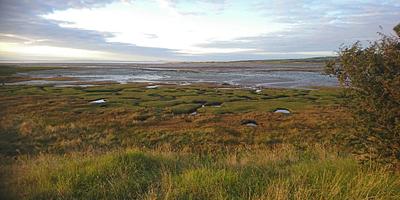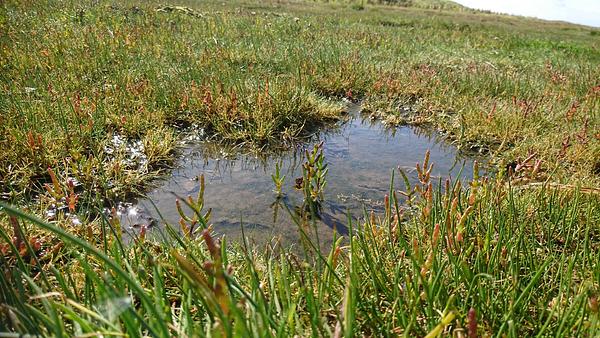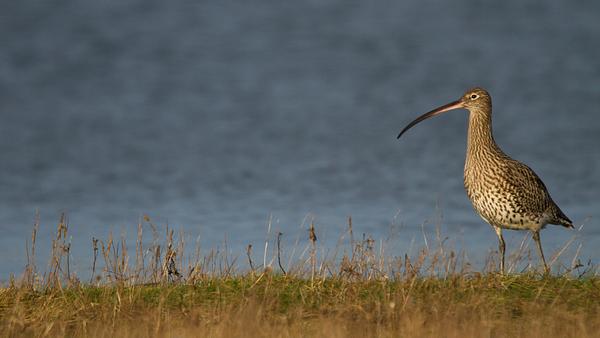
SALT MARSHES
Coastal saltmarshes are upper, vegetated portions of intertidal mudflats.
Saltmarshes are amongst the most abundant and productive coastal ecosystems around the world, providing sanctuary for a great number of protected species.
"Scotland has 7,076 hectares of saltmarsh, 77.4% of which lie within Sites of Special Scientific Interest” - NatureScot
They are a UK BAP Habitat (Biodiversity Action Plan) and also provide us with benefits, including; natural buffers to storm damage; flood defences; nurseries for economically important fish; carbon sinks (somewhere excess carbon is absorbed from the atmosphere); sites for cattle grazing; and the improvement of water quality.
Coastal saltmarsh is widespread around Scotland, especially along the shores of Firths such as the Firth of Forth and Firth of Tay.
FORMATION
Saltmarshes form in intertidal areas (areas exposed at low tide) where water flow is slow enough for fine sediments to settle and form beds of mud stable enough for vegetation to grow, e.g. sheltered estuaries and bays.
Over time, more and more sediment is deposited and beds of plants rise up above water level. These beds are interspersed with channels of water and isolated pans (pools), creating islands of vegetation.
Salt marshes get their name from the high concentrations of salt that get deposited within their sediments during each incoming tide.
INHABITANTS
Plants
The vegetation that makes up the marsh consists of grasses, shrubs, bushes and flowers. These terrestrial plants have evolved some incredible coping mechanisms to be able to withstand salty conditions, such as salt excretion, small leaves and thick stems. In fact, terrestrial species living in habitats like this are known as ‘halophiles’ – ‘salt-loving’ organisms.
Low down the marsh, common plant species include sea aster (Aster tripolium), common saltmarsh grass (Puccinellia maritima) and glassworts (Salicornia spp.).

Cord grass is a ‘pioneer species’, meaning it is often the first to colonise areas of bare mud. As they grow, their roots bind the mud and their stems slow the flow of water, eventually creating conditions favourable enough for other species of plant to move in to the area. Over time, sediment builds up and beds of plants start to appear above channels of water.
Species commonly found in the most landward areas are red fescue (Festuca rubra), sea plantain (Plantago maritima), sea milkwort (Glaux maritima) and sea purslane (Halimione portulacoides).
As the amount of plant life increases on the marsh, so does the amount of organic material available for decomposition. Just like mud flats, the breakdown of all this rotting material leads to a nutrient-rich habitat able to support a wide variety of animals.
Animals
Dig down into the mud at low tide you’ll be greeted by worms, snails and crabs.
Above the mud, the long grasses provide safe sites for breeding, migrating and wintering birds. Species of special conservation status recorded in this habitat include curlew (Numenius arquata), lapwing (Vanellus vanellus), herring gull (Larus argentatus), skylark (Alauda arvensis) and starling (Sturnus vulgaris). Around half of British redshanks (Tringa totanus) also breed on salt marshes.

Saltmarshes are home to a variety of insects including ground beetles (e.g. the saltmarsh shortspor Anisodactylus poeciloides), the narrow-mouth whorl snail (Vertigo angustior) and species of bee (e.g. Colletes halophilus). It also provides suitable habitat for the natterjack toad (Epidalea calamita).
Small mammals, such as spcies of shrew, mouse and vole, take advantage of the feast of invertebrates in the upper parts of the marsh.
The wetter parts of saltmarshes are also ideal habitats for fully-grown species of fish such as sand goby (Pomatoschistus minutus).
LOCALISED THREATS
In addition to the large-scale threats facing the marine environment, salt marshes are at risk from the following:
- Coastal development
- Human pollution - agricultural and urban runoff add harmful nutrients and chemicals to the environment
- Human activities, such as fishing and trampling.
- Dredging - Removal of sand from harbours and shipping lanes and dumping offshore upsets the flow of sediments in/out of ecosystems.
- Adverse weather - erodes the marsh and floods nests of birds.
- Coastal squeeze - As sea levels rise, salt marshes infront of hard sea defences aren't able to shift with the changing conditions resulting in the loss of the upper parts of the marsh.
- Over grazing - cattle are often sustainably grazed on upper parts of saltmarshes, but too many can result in trampling and reduction of suitable nesting sites for birds.
